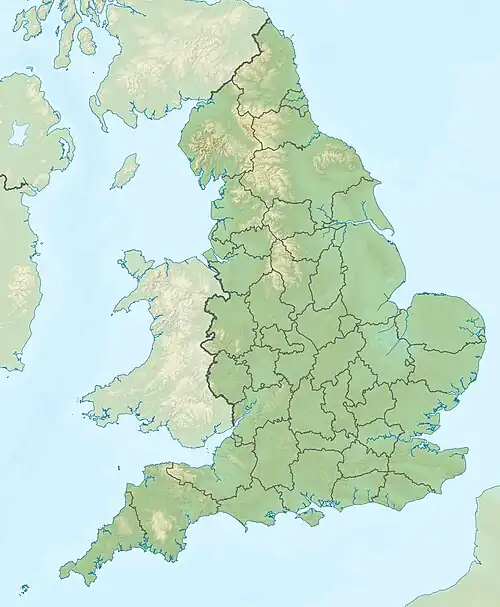| Cambridge Greensand | |
|---|---|
| Stratigraphic range: Earliest Cenomanian ~ | |
| Type | Member |
| Unit of | West Melbury Marly Chalk Formation |
| Underlies | Chalk Group |
| Overlies | Gault Formation |
| Thickness | 0.1–1 m (0.33–3.28 ft) |
| Lithology | |
| Primary | Glauconitic marl |
| Other | Phosphorite |
| Location | |
| Coordinates | 52°12′N 0°06′E / 52.2°N 0.1°E |
| Approximate paleocoordinates | 41°00′N 1°48′E / 41.0°N 1.8°E |
| Region | England |
| Country | |
| Extent | North Hertfordshire and Cambridgeshire |
| Type section | |
| Named for | Cambridge |
| Location | Arlesey Brickpit |
 Cambridge Greensand (England) | |
The Cambridge Greensand is a geological unit in England whose strata are earliest Cenomanian in age.[1] It lies above the erosive contact between the Gault Formation and the Chalk Group in the vicinity of Cambridgeshire, and technically forms the lowest member bed of the West Melbury Marly Chalk Formation.[2] It is a remanié deposit, containing reworked fossils of late Albian age, including those of dinosaurs and pterosaurs.
Description
The lithology is made out of glauconitic marl, described as a "chalk mud", containing abundant ostracod, coccolith and foram remains, with a concentration of phosphatic nodules and bones at the base.[1][2]
Vertebrate paleofauna
Birds
- Enaliornis barrette - "Braincases, vertebrae, pelvis [and] limb elements.."[3]
- E sedgwicki - "Hindlimb elements."[3]
- E. seeleyi - "Assorted cranial and postcranial elements"
Dinosaurs
Ornithischians
- Anoplosaurus curtonotus - "Partial postcranium."[4]
- A. major - "Cervical vertebrae."[4] "Vertebrae."[5]
- Acanthopholis eucercus - "[Two] caudal centra."[4]
- Acanthopholis platypus (in part) - "Phalanx, caudal centra."[4]
- Acanthopholis macrocercus (aka Syngonosaurus) - "Osteoderms."[4] "Vertebrae, fragmentary skeleton elements."[5]
- Acanthopholis stereocercus - "Osteoderms."[4] "Vertebrae."[5]
- Eucercosaurus tanyspondylus - "Vertebrae."[4]
- Trachodon cantabrigiensis - "Dentary tooth."[6]
Saurischians
- Macrurosaurus semnus - "Caudal vertebrae"[7]
Pterosaurs
- Amblydectes crassidens
- A. eurygnathus
- Camposipterus colorhinus
- C. nasutus
- Camposipterus sedgwickii
- Draigwenia platystomus
- Lonchodraco machaerorhynchus
- Lonchodraco microdon
- Ornithocheirus simus[8][9]
- Nicorhynchus capito
- "Ornithocheirus" denticulatus
- "Ornithocheirus" polyodon
- Ornithostoma sedgwicki[10]
Ichthyosaurs
Lepidosauria
Invertebrates
Ammonites
- Salaziceras (Salaziceras) salazacense[13]
See also
References
- 1 2 Hart, Malcolm B.; Fox, Lyndsey R. (2020). "Micropalaeontology and stratigraphical setting of the Cambridge Greensand". Geological Society, London, Special Publications. 498 (1): 147–163. Bibcode:2020GSLSP.498..147H. doi:10.1144/SP498-2018-144. ISSN 0305-8719. S2CID 210304478.
- 1 2 Cambridge Greensand at BGS
- 1 2 "Table 11.1," in Weishampel, et al. (2004). Page 215.
- 1 2 3 4 5 6 7 "Table 17.1," in Weishampel, et al. (2004). Page 367.
- 1 2 3 "Table 19.1," in Weishampel, et al. (2004). Page 417.
- ↑ "Table 20.1," in Weishampel, et al. (2004). Page 443.
- ↑ "Table 13.1," in Weishampel, et al. (2004). Page 270.
- ↑ Taissa Rodrigues & Alexander Wilhelm Armin Kellner (2013). "Taxonomic review of the Ornithocheirus complex (Pterosauria) from the Cretaceous of England". ZooKeys (308): 1–112. doi:10.3897/zookeys.308.5559. PMC 3689139. PMID 23794925.
- ↑ Unwin D.M., 2001, "An overview of the pterosaur assemblage from the Cambridge Greensand (Cretaceous) of Eastern England", Mitteilungen aus dem Museum für Naturkunde in Berlin, Geowissenschaftliche Reihe 4: 189–221
- ↑ Averianov A.O. (2012). "Ornithostoma sedgwicki – valid taxon of azhdarchoid pterosaurs". Proceedings of the Zoological Institute RAS. 316 (1): 40–49.
- ↑ Valentin Fischer; Nathalie Bardet; Myette Guiomar & Pascal Godefroit (2014). "High Diversity in Cretaceous Ichthyosaurs from Europe Prior to Their Extinction". PLOS ONE. 9 (1): e84709. Bibcode:2014PLoSO...984709F. doi:10.1371/journal.pone.0084709. PMC 3897400. PMID 24465427.
- ↑ P. M. Barrett and S. E. Evans. 2002. A reassessment of the Early Cretaceous reptile 'Patricosaurus merocratus' Seeley from the Cambridge Greensand, Cambridgeshire, UK. Cretaceous Research 23:231-240
- ↑ C. W. Wright and W. J. Kennedy. 1979. Origin and evolution of the Cretaceous micromorph ammonite family Flickiidae. Palaeontology 22:685-704
This article is issued from Wikipedia. The text is licensed under Creative Commons - Attribution - Sharealike. Additional terms may apply for the media files.